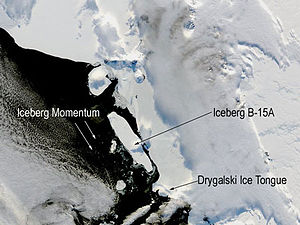B-15 A
The iceberg B-15 A in Antarctica was formed from the 11,000 square kilometer iceberg B-15 when it broke into several pieces in the course of 2000, 2002 and 2003. The largest remaining piece had a size of 6,400 square kilometers and was named B-15 A. After that, the C-19 A near a French research station in Antarctica was considered the largest of its kind.
The name comes from the place where the iceberg was first sighted: The B stands for 90 ° to 180 ° west longitude ( Amundsen Lake , eastern Ross Sea ), the C stands for 90 ° to 180 ° east longitude (western Ross Sea, Wilkesland ).
In 2005, B-15 A was about 3,000 square kilometers and about 140 kilometers long and was considered the largest free-swimming object on the ocean .
In a collision with the Drygalski ice tongue , this became five kilometers shorter, the broken mountain is now called C-16.
Web links
Individual evidence
- ↑ Kevin R. Arrigo, Gert L. Van Dijken: Annual changes in sea-ice, chlorophyll a, and primary production in the Ross Sea, Antarctica . In: ScienceDirect (Ed.): Deep-Sea Research Part II: Topical Studies in Oceanography . 51, No. 1-3, January-February 2004, pp. 117-138. bibcode : 2004DSRII..51..117A . doi : 10.1016 / j.dsr2.2003.04.003 . Retrieved September 7, 2018.


